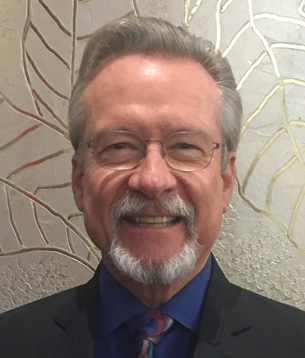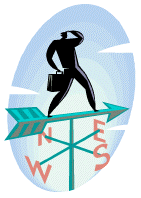

It has been a terrific 2007 and we anticipate an action-packed fall season to close out the year. Our three service areas -- Leadership Coaching, Management/Communications Workshops, and Organizational/Individual Effectiveness Surveys -- are now equally balanced and growing. Bill Terry and I continue to devote much of our time to one-on-one executive and manager coaching. Our most recent extension of the coaching work is our Leadership Lab®, which you will learn more about later in this publication.
Although our work tends to reside on the West Coast, we have had some exciting assignments in Nova Scotia, Toronto, and Hawaii (tough duty but someone has to do it!). Bill and I also had the pleasure of spending an afternoon with 100 managers of federal government agencies on 360 Degree Leadership and how to bring High Performance Leadership into their workforce.
The growth in our Assessment/Survey design and administration services has kept Alan Wright, Ph.D. and Dean Kazoleas, Ph.D. busy into the wee hours of many mornings crunching and analyzing mountains of data. To support their efforts we have just launched an exciting new survey platform that allows our clients to view real-time reports showing progress and trends during the survey administration phase. We also now offer a survey invitation service that frees up our client's staff and provides more control throughout the administration process with this new technology. I look forward to presenting this new assessment platform to anyone planning a leadership or organizational assessment.
We are truly blessed to be able to continue serving our current and new clients in developing and delivering fresh and vibrant leadership development services. Thank you to our friends, colleagues, and clients for inviting us into your lives and organizations to bring a positive impact to the workplace through High Performance Leadership.
 Respectfully, Mark Gross, President LSL
Respectfully, Mark Gross, President LSL

Jack Welch has said that management development sessions can be more effective with "your own managers in front of the class" (IdeasTheWelchWay, BusinessWeek, August 13, 2007). Using your own managers as facilitators, Welch adds, "demonstrates for employees what success thinks and acts like in your organization."
At Leadership Services, we know that leadership development has to be about your organization—not a stock set of theories and models. We've always customized our services to match our clients' needs. With our Leadership Lab® (LLAB), we have gone a step further, and we're excited to report that it's been extremely successful thus far.
The LLAB model is highly interactive, ideally with 80% participant interaction and 20% content delivery. We recommend it be two days, off site, with a group dinner, and held twice each year. The session is kicked off by a senior leader with a presentation and then an open forum for discussion.
But what distinguishes the LLAB from other development sessions is its facilitation structure. We include client managers in facilitation of the program, and we do this for two primary reasons: (1) Manager-facilitators move beyond their comfort zone and get an opportunity to demonstrate their leadership; and (2) Manager-participants receive the most accurate and relevant information in the session, because it's coming from their own managers. Our role as consultant is to help guide the facilitators so that they become effective trainers. Jack Welch adds that, with managers in the facilitator role, there is a lot of growth and a lot of fun. We've found both are true.
From an organizational learning standpoint there is an efficiency and predictability that comes from delivering training such as Customer Service, Basic Management Skills, Total Quality Improvement, and other related Human Resource topics from a central source, whether using inside or outside resources. On the other hand, leadership development is an organic and ongoing process. Leadership skill transfer needs to be relevant to the current demands of the role in today's dynamic business environment. Central source training is always challenged by relevancy to the immediate needs of the day. Leadership Labs® serve to integrate best practices with an immediate application to today's needs.
A client who participated in a recent Leadership Labs® session said this:
"I want to thank you so much for the Leadership Lab last week. After my ten years working for Wells Fargo Mortgage, I can say that was one of the best meetings I ever attended. I really look forward to working on your team and helping the team grow the market. I know I can learn even more under your guidance."
We look forward to offering more LLABs and helping managers develop into leaders. For more information about Leadership Labs® click here >
Phase Two consists of action-planning and implementation based on the assessment results. Out of a dialogue with appropriate stakeholders or management, who decide development priorities, we then assist with implementation via one or more of our services.
More surveys:
For this edition of our newsletter I've reviewed a book released last year, How: Why How We Do Anything Means Everything...in Business (and in Life), by Dov Seidman. As a leadership coach, I am always looking for new ways to stretch my clients and help bring about learning that doesn't occur in every day work and play. Research has demonstrated that communications are 55% visual (body language, facial expression, etc.), 38% tone of voice, and 7% what we take in while listening to the words spoken. For this reason, much of my work focuses on executive presence and how we interact with others."
Increasing demands in business combined with available technology encourages the practice of multi-tasking. The use of Blackberries, text messaging, and teleconferencing continues to grow as a means of interaction. The unintended consequence for replacing relationship development and trust building with technology-based communication is what I call "Interpersonal Transaction Management" (ITM). What is troubling is that I meet professionals who are attempting to excel and who view their ITM abilities as a competitive advantage. Clearly, efficiency in coordinating effort and organization is critical, but not at the expense of relationship and trust management. I realize this is obvious, yet I often hear others say, "I just don't have the time I would like to spend with my customers and employees. There is just too much to do."
Dov Seidman's research described in "How" adds new dimensions to the importance of how we interact with others in our personal and business lives. I have said for years that "results alone do not spell success; it is the integration of relationships and results that paint the true picture of abundance and healthy success." Dov's premise is that the drive for differentiation to compete and win is becoming more difficult in our commoditized world. He goes on to say that there is one area where tremendous variation and variability still exists, human behavior, or how we do what we do. One of his illustrations is about how to "out-behave" the competition, and that:
Behavior is something you can control. If you reach out and inspire more people throughout your global network, you win. If you collaborate more intensely with your co-workers, you win. If you keep promises 99 percent of the time and your competitor keeps promises only 8 out of 10 times, you win.
This kind of predictability also builds trust. Dov illustrates that trust is a drug that the body produces called oxytocin (The so-called bonding hormone secreted by the pituitary gland). At a basic level, Dov explains, we are all hardwired to find opportunities to help and connect with others. When we meet or see someone that appeals to this serving opportunity, the hormone is triggered and we experience a desire to be in relationship. With this, we can see how important first impressions displayed through body language and tone can be.
Another set of illustrations presented in the book relates to culture. The notion of how individuals behave as leaders has a profound impact on an organization's culture. Dov makes the soft stuff of culture clear by examining how we can: pursue, recognize, relate, behave, and know. His perspective on how to get agreement on cultural norms and practices could be very helpful for those of us who diagnose and address culture fit and change issues.
If showing up is half the battle, I suggest how you show up gets you 75% of the way there in our flattened and accelerating world. For more information on this groundbreaking work, check out Dov's website at www.howsmatter.com.
Give it a try; I think you'll enjoy the book. As always, I look forward to hearing about your personal adventures in learning.
Sincerely, Mark Gross
Where is the wisdom we have lost in knowledge? Where is the knowledge we have lost in information? - T.S. Eliot